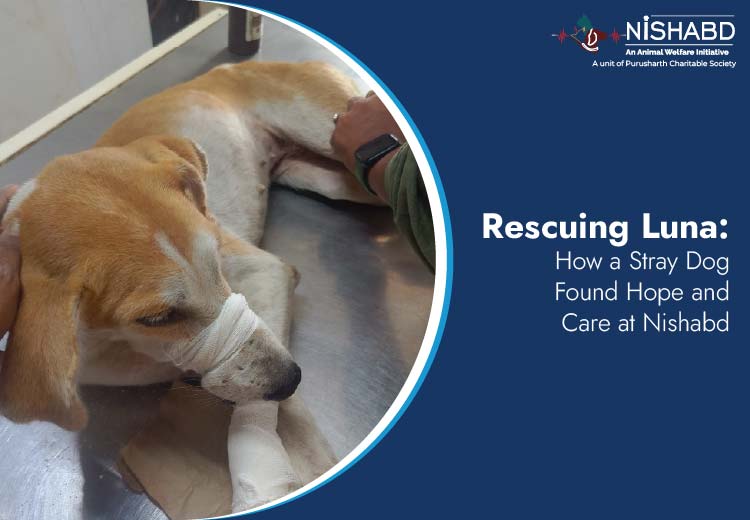Every day, many little street dogs are trying very hard to live. They feel hungry, they get hurt, they fall sick, and many times they feel very lonely because no one is there to care for them. They cannot speak or ask for help, so they suffer quietly. Even one small kind action from us can make their world feel warm and safe. If you have ever thought, “I want to help dogs,” and wondered how to donate to a dog shelter, this simple guide is just for you.
In Noida, Nishabd Animal Shelter is one such place that works all day and all night to save, heal, and protect dogs who do not have a home. Giving to a shelter like Nishabd is not only about money. It is about giving love, care, hope, and a new chance to live a happy life.
Why Donating to a Dog Shelter Matters
Donations help shelters keep going every single day. Taking care of many dogs needs food, medicines, clean space, and caring people. Shelters cannot do this work alone. Every little help, whether big or small, saves lives.
When you donate to a dog shelter in Noida, you help to:
- Give food to dogs who are very hungry
- Help dogs who are hurt or sick feel better
- Buy vaccines and medicines to keep dogs safe
- Keep the shelter clean and comfortable
- Help rescue dogs from unsafe places
Your kindness becomes part of a dog’s happy healing story.
About Nishabd Animal Shelter
This animal shelter is in Noida and works only to help street dogs and animals who are left alone. The people here believe that every dog deserves love, respect, and gentle care.
Nishabd is not just a shelter. It is like a safe home where dogs can rest, heal, and feel loved again. Their work is based on kindness and care, and their mission includes:
- Saving dogs from dangerous situations
- Giving medical help and vaccines
- Providing healthy food and a clean place to stay
- Helping dogs find loving forever families
- Teaching people to care about animals
This caring heart is why Nishabd is known as a trusted dog shelter in noida that many people support with love.
Ways You Can Donate to an Animal Shelter
Helping does not always mean giving money. There are many easy ways you can help dogs.
- Monetary Donations
Money donations help the shelter buy food, medicines, pay for treatments, surgeries, and keep the shelter running. Even a small amount can help a dog feel better.
You can usually donate through:
- Online payment methods
- Bank transfers
- Special donation drives
Every rupee helps a dog smile again.
- Donate Food and Supplies
Shelters always need useful things. You can donate:
- Dog food and small treats
- Blankets and soft mats
- Medicines (after asking the shelter)
- Cleaning items
These things help dogs stay healthy, warm, and comfortable.
- Support Medical Care
Many dogs come to the shelter hurt or very sick. Medical care costs a lot. Donations for medicines, vaccines, and surgeries help dogs heal faster and live without pain.
- Sponsor a Dog
Some shelters let you take care of one dog by sponsoring them. This means you help pay for that dog’s food, medicine, and care for a month or more. It is a sweet way to feel close to a rescued dog.
Beyond Donations: Other Ways to Help
If you cannot donate right now, you can still help a dog shelter in Noida like Nishabd in many kind ways.
- Volunteer Your Time
Shelters are happy when people come to help. You can:
- Feed the dogs
- Help with cleaning and brushing them.
- Sit down with them and offer them your love.
- Help during special events
Dogs feel very happy when someone spends time with them.
- Spread Awareness
Talking about Nishabd, dog adoption, or donation needs with friends or on social media helps more people learn and care.
- Adopt or Foster
Adopting a dog gives them a forever home full of love. Fostering helps dogs learn home life while waiting for adoption.
Why Your Donation Truly Matters
When you donate, you are helping in real life. For a dog who was scared, hungry, or hurt, your kindness brings food, safety, warmth, and healing.
Nishabd works honestly and lovingly. Every donation is used carefully to help dogs who depend on humans to survive. Supporting a dog shelter in Noida helps make the world kinder and softer for animals.
A Small Act, A Big Change
You do not need to be rich to help. A kind heart is enough. Whether you give money, food, time, or just tell others – everything counts.
Together, we can make sure no dog feels hungry, hurt, or alone.
FAQs
- Can I donate a small amount to a dog shelter?
Yes, even a small donation can help buy food or medicine for a dog.
- Is it safe to donate to animal shelters?
Yes, trusted and registered shelters use donations to care for animals.
- What items do dog shelters need the most?
Food, medicines, blankets, and cleaning items are always helpful.
- Can I visit a dog shelter before donating?
Yes, many shelters welcome visitors who want to see their work.
- Is helping with time as good as giving money?
Yes, love, care, and time are just as important as money.















